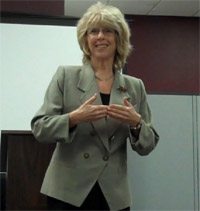A Note from Bonnie K.
 “I work with you in a two way, non-verbal, conversation. I have you in a supported comfortable position first. I listen closely to your Nervous System’s response to my touch and support and then I respond to your response. I test how much any part is willing to be moved and put it down if I feel a nonverbal message not allowing the movement to happen. I am having a conversation with you nonverbally even though your ‘logical’ mind might not understand.
“I work with you in a two way, non-verbal, conversation. I have you in a supported comfortable position first. I listen closely to your Nervous System’s response to my touch and support and then I respond to your response. I test how much any part is willing to be moved and put it down if I feel a nonverbal message not allowing the movement to happen. I am having a conversation with you nonverbally even though your ‘logical’ mind might not understand.
I’m respectful to responses from your autonomic nervous system even though your mind thinks I could be doing more. I’m quietly ‘listening’ as a horse whisperer might.
Some people take longer to tune into their bodies and movements than others. Participating in The Feldenkrais Method (group, individual or combination) is a ‘program’ for learning. The ultimate goal is learning in a way you can continue learning and become more self-reliant.
At some level we all have conversations with ourselves. Consider the possibility of twisting an ankle or wrist. Initially it’s painful and your whole self can only hear the pain. But when the pain starts subsiding, your body gives you signals, and you hear an inner voice saying “this is ok to do … this is not”. I work to encourage everyone to respect those signals and start to ask-meta questions everyday;
Do I want to continue even though it hurts?
If I try it this way could I find more comfort?
Can you sense what is moving when you inhale or exhale?
I encourage you to always trust yourself and look for a new option anytime an action causes strain or discomfort. We are fluid, changing human beings. That is why heightening your awareness to how you do what you do (meta-knowing) to Moshe Feldenkrais, D.Sc., was the most valuable learning.
Moshe Feldenkrais, D. Sc. believed that the most productive process for learning is when you take yourself out of gravity, and allow yourself to feel support of your bones on a table or chair. This is where your nervous system feels safe enough to quiet old patterns and sense subtle, new variations. Soon you realize the enormous capacity you have to change those unconscious patterns (held in your brain) and create new possibilities for yourself. Feldenkrais’ belief in the ability for the brain to change in the 60s is why Moshe Feldenkrais, D.Sc. is labeled a ‘pioneer in neuroplasticity’ by Norman Doidge M.D.”
Links:
About Bonnie Kissam, M.A.
.
